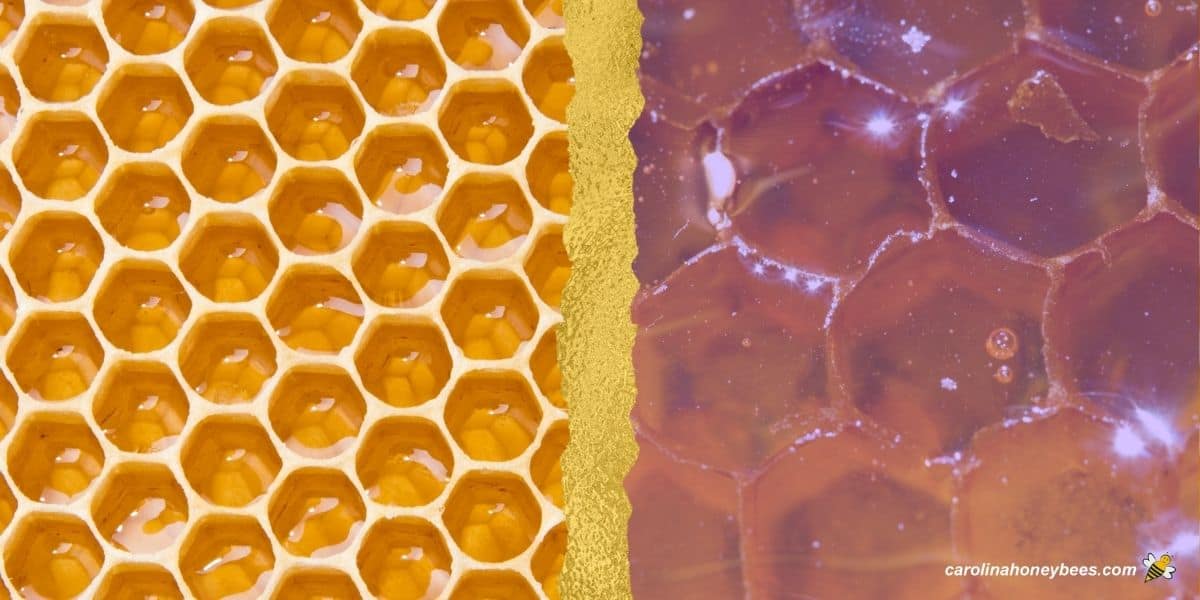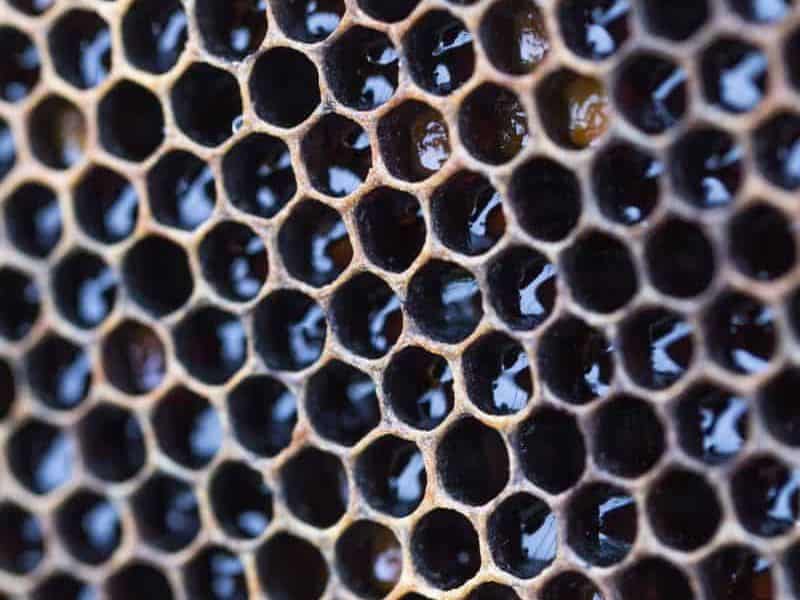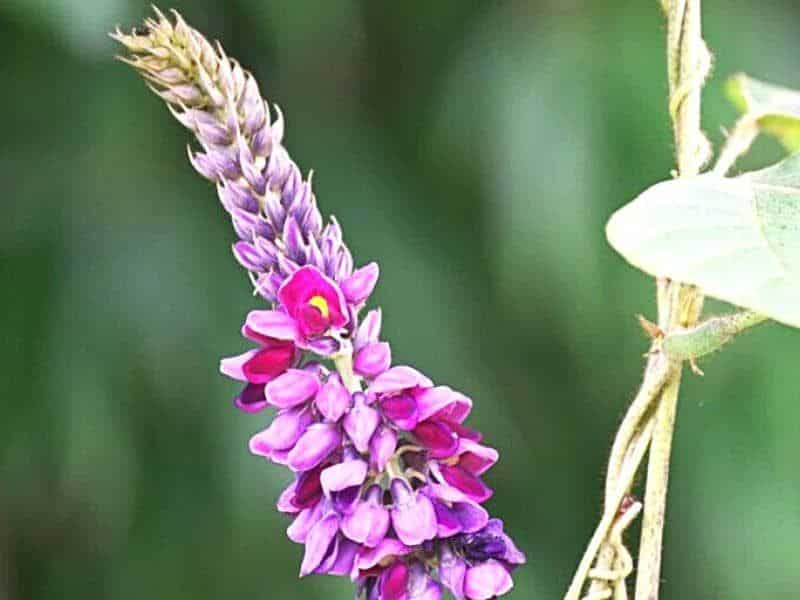Unique Purple Honey
If you have heard the rumors about beekeepers producing purple honey, you are not alone. But, from where does this special product come? The wide variety of nectar sources bees visit results in honey that may be light or dark in color – but what about blue or purple? Yes, it does happen – let’s explore some common theories to explain this phenomenon.

Of course, when you first read about purple honey – you might think that some coloring has been added to it. Unfortunately, that does happen on occasion but not in this instance. The color of this honey truly has a purple tint! Let’s dive in and try to solve this mystery.
What is Purple Honey?
Can this be real- purple honey? Our winged friends do have a craving for sweet liquids. In times of dearth, or nectar shortages, they may gather anything sweet that they can find.
This is why we sometimes read news articles about beekeepers that have harvested honey in some rather outrageous colors. These bright orange, deep red or even green colored jars of honey usually end up not being true the real thing.
Rather, the source is found to be some type of commercial candy dye etc that a bakery or candy store has discarded. The bees obviously thought it tasted good so they brought it home and stored it in the comb.
However, the saga of purple honey does seem to have a foundation in truth. Beekeepers in some regions do occasionally harvest honey that is well… blue or purple.
Actually, the color varies from just a hint of blue to a true-blue honey and even a deep purple. Nothing has been added and the product seems to be real bee honey. How can this be?

Possible Nectar Sources
As with many things in the beekeeping world, there is much disagreement on the origin of purple honey. Yet, there are several theories commonly used to explain this phenomenon.
The top 3 explanations for this oddity:
- bees are harvesting juice of dark berries
- bees are visiting a nectar source such as kudzu
- or there is a aluminum-rich nectar source
Fruit Juices
Honey bees will drink juice from ripe fruit. Though they are often only sucking juices from holes made by larger bees.
This is a key difference between honey bees and bumble bees, Honey bees do not have strong enough teeth to puncture tough skins.
Many beekeepers insist that bees foraging these fruits is the most likely source of blue honey. They say it is simply honey made using fruit juice.
But, dark fruits such as elderberries, blueberries or blackberries have not been in bloom in all locations where this rare blue-colored honey has appeared.

Kudzu
Good old Kudzu – the bane of southern existence produces beautiful little purple flowers. They smell like grape flavored Kool-Aid.
Honey bee colonies that are near large areas of kudzu are known to produce honey that has a purple tint and some grape flavor.
I have had Kudzu honey and it is rather good. While not a favorite flower of honey bees, they will work kudzu blooms during dry times.
Yet, honey with the purple or blue tint also occurs from time to time in regions of the country that do not have kudzu plants.
Aluminum-Rich Nectar
Perhaps there is another plant in those areas that is responsible for this color of honey and grape taste? The Summer Titi (Southern Leatherwood flowers) has likewise been suggested as a source.
Some have even suggested that it might be a result of Sourwood trees? But I am very skeptical of the sourwood plant as a source. I make sourwood honey and have never had honey that was purple.
There may be a correlation between blue honey and plants with a high aluminum content in their nectar.
Science Behind Purple Honey
This brings us to one of the most popular theories. N.C. State University Professor, John Ambrose, performed a series of tests in the 1970’s to determine the source of purple honey.
His research found that field bees coming back to the hive did not have blue nectar in their honey stomach. But, his studies suggested that nectar gathered was from plants with a higher aluminum content.
Perhaps, this aluminum then interacted with the acidic environment in the digestive fluid of the bees stomach. The final step during the honey making process resulted in the purple color.
Geographical Distribution
So, is it a result of bees foraging on berry juice, a simple nectar source such as Kudzu or reactions to aluminum rich nectar in the honey stomach of bees? The mystery continues.
This rare honey seems to occur mainly in the southeastern part of the country. It is most common in the areas of the Carolina coastal plains -especially the sandhills of North Carolina.
It is more prevalent in some years than others and tends to show up more in dry years.
FAQs
Ask beekeepers in certain regions (especially the NC sandhills) and they will say that “yes – bees can produce purple colored honey.
As honey type is defined by nectar source – we are not sure of the source for purple honey. One possible source is the Kudzu plant.
Yes, purple honey is generally safe to consume. However, it’s essential to ensure its authenticity and quality. Purchase from reputable sources and check for any certifications to guarantee purity.
Yes, purple honey has a long shelf life – the same as regular honey. Proper storage in a warm, dry place is crucial to prevent crystallization and maintain its quality over time.
Final Thoughts
We love unique things and even though this honey may not really be any better than another – it is intriguing. Even more puzzling, some hives in the apiary produce a small amount of the special honey. While others in the same bee yard produce none! How can this be? Well, we really don’t know and the bees are not talking.
One thing is sure. If you are a beekeeper that is lucky enough to harvest this specialty type of honey, it should fetch a premium price. Sell your honey product for more than the regular jars.

